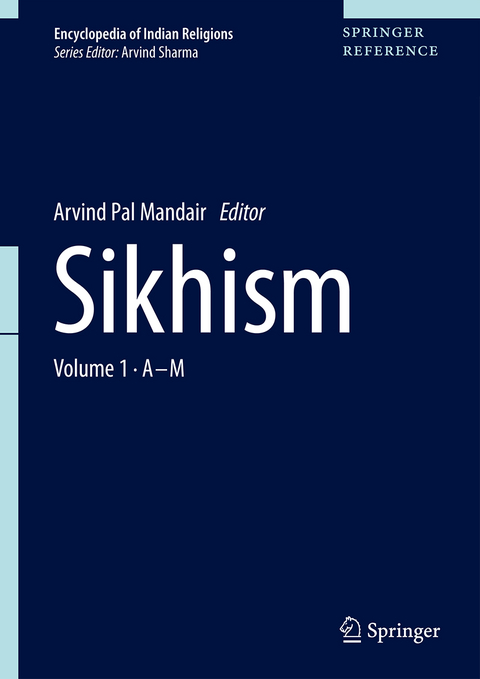
Sikhism
Springer (Verlag)
978-94-024-0845-4 (ISBN)
This volume describes Sikhism, the youngest member of the Indic religious traditions. It looks at the striking features of this tradition and describes its birth in the fifteenth century and its continual evolution between the sixteenth and late twentieth centuries into an independent formation often described as the “world’s fifth largest religion”. The volume explains how Sikhism arose at a time of religious and political ferment, a fact which left its mark on its interactions with other traditions, notably Islam, Christianity and Hinduism. The volume illustrates that Sikhism’s political aspirations may not have been fully met by the establishment of the nation state of India in 1947, as indicated by the demand by its adherents for greater autonomy which occasionally has spilled over into claims for independence. It pays attention to the fact that Sikhism is isomorphic with Buddhism and Jainism inasmuch as the demographically minority status of all of these religious traditions conceals the vast influence they have exerted on the Indian landscape. In addition the volume analyses the relationship between complex themes such as violence and mysticism, politics and religion, tradition and modernity, as they have manifested themselves in the historical evolution of the Sikh community. It provides a useful introduction to the lives of its founders, their philosophical and ethical teachings and to Sikh responses and interactions with the world’s major religious traditions in an increasingly pluralistic world.
Arvind-Pal Singh Mandair is an Associate Professor and holder of the S.B.S.C. Endowed Chair in Sikh Studies at the University of Michigan, USA. His books include: Sikhism: A Guide for the Perplexed (Bloomsbury, 2013), Religion and the Specter of the West: Sikhism, India, Postcoloniality and the Politics of Translation (Columbia, 2009), Teachings of the Sikh Gurus (with Christopher Shackle, 2005), Secularism and Religion-Making (Oxford, 2009). He is a founding editor of the journal Sikh Formations: Religion, Culture and Theory.
From the contents:
Accuracy.- Acquaintance.- Actuality.- Aesthetics (Sikhism).- Akali.- Akali Dal.- Akali Dal.- Akali/Akali Dal.- Akhand Path.- Alue.- Amar Das (Guru).- Amritdhari.- Amritsar.- Anand Sahib.- Anandpur Sahib Resolution.- Anhad Nad.- Anna Prasanam.- Annaprashana.- Antithesis.- Apprehension.- Architecture.- Architecture (Sikh).- Architecture (Sikhism).- Argumentation.- Arjan (Guru).- Art.- Art (Sikh).- Art (Sikhism).- Ashta Samskara.- Atma.- Aum.- Authority (Sikhism).- Autonomy for Punjab.- Banda Bahadur.- Bani.- Belief.- Bhagats.- Bhagats.- Bhagti.- Bhagti (Bhakti), Sikhism.- Bhakti (Bhagti).- Bhindrawallah.- Blue Star (Operation).- Bodhi.- Bowing Bards.- British Empire.- Buddhi.- Buildings.- Calendar (Nanakshahi), Sikhism.- Cardinal Virtue.- Caste (Sikhism).- Chief Khalsa Diwan.- Coherence.- Colonial-Era Punjab.- Colonialism.- Comparative Study of Religions.- Comprehension.- Connection.- Consciousness.- Consciousness (Sikhism).- Corruption.- Creation.- Creator.- Dal Khalsa.- Dalip Singh, Maharaja.- Darshan.- Darshan.- Dasam Granth.- Dastaar.- Dates.- Death (Sikhism).- Debauchery.- Deduction.- Degeneracy.- Desi and Margi.- Design.- Devotionalism.- Dhadi Var.- Dhadi(s).- Dharam.- Dharam.- Dharam (Sikhism).- Dhyana.- Dialectic.- Diaspora.- Diaspora.- Diaspora (and Globalization).- Distinction.- Divisions.- Dreams (Sikhism).- Dumulla.- Embodiment.- Emerit.- Enlightenment.- Ethics (Sikhism).- Ethnography.- Exactness.- Excellency.- Fact.- Factuality.- Faith.- Fate (Destiny), Sikhism.- Festivals.- Festivals (Sikhism).- Foible.- Folklore (Sikhism).- Frailty.- Genuineness.- Ghadar Movement.- Ghaddhar.- Ghadhar.- Globalization.- Gobind Singh (Guru).- Golden Temple.- Grace.- Groups.- Guide.- Guide (Sikh).- Gurbani Kirtan.- Gurbani-Keertan.- Gurbani-Kirtan.- Gurdas Bhalla, Bhai.- Gurdwara Reform Movement.- Gurgaddi.- Gurmat.- Gurmat Sangeet.- Gurmatta .- Gurmat-Sangeet.- Gurmukh.- Gurmukhi Script.- Guru.- Guru Amar Das.- Guru Granth Sahib.- Gutka.- Har Krishan, Guru.- Har Rai, Guru.- Hargobind (Guru).- Hermeneutics (Sikhism).- Historical Research on Sikhism.- Historical Sources (Sikhism).- Historiography (Sikhism).- Historiography (Sikhism).- History (Sikhism).- Hukumnama.- Hymns of the Sikh Guru.- Image.- Immorality.- Imperial Power and Sikh Tradition.- Indian Army.- Induction.- Inference.- Insight.- Instruction.- Intellection.- Intelligence.- Janamsakhis.- Japa.- Japji.- Japji Sahib.- Jati.- Jivan-Mukti.- Juga.- Kaal.- Kabir.- Karam.- Karma.- Karnavedha.- Keertan.- Keshkee.- Khalistan.- Khalsa.- Khalsa.- Khalsa.- Khālsā.- Kirtan.- Kirtan (Sikhism).- Kirtaniya.- Kirtankar.- Knowledge (Gian), Sikhism.- Law and Justice (Sikhism).- Legal Orders.- Legitimacy.- Licentiousness.- Linkage.- Logic (Sikhism).- Love.- Love (Sikhism).- Mahant.- Maharaja Dalip Singh.- Maharajah Ranjit Singh.- Man.- Mantra.- Marriage (Sikhism).- Martyrdom (Sikhism).- Maryada.- Meditation (Sikhism).- Merit.- Migrant.- Migration, Sikh.- Mind (Sikhism).- Mirasi(s).- Mīrī Pīrī.- Misl(s).- Modern.- Modernism.- Modernity (Sikhism).- Moksha.- Mughal/Sikh Relations.- Music.- Music (Sikh Popular and Religious).- Naam.- Nadar.- Nam Japna.- Nam Simran.- Nam (Sikhism).- Namadeva.- Namdeo.- Namdev.- Nanak (Guru).- Niramalas.- Niramale.- Nirgun Bhakti.- Nirmala(s).- Nirmale.- Nitnem.- Orientalism (Sikhism).- Pagri.- Parchar.- Performance.- Persian Literature.- Persian Sources (and Literature) on Sikhs.- Philosophy.- Philosophy (Sikhism).- Pilgrimage (Sikhism).- Poetry.- Poetry of the Sikh Gurus.- Political Authority.- Postcoloniality.- Prachar.- Precision.- Punjab.- Punjabi Language.- Punjabi Literature.- Raag.- Raaga.- Rababi.- Race (Sikhism).- Ragas (Sikhism).- Ragis (in Sikh Kirtan Tradition).- Rahit.- Rahit Maryādā (Code of Conduct), Sikhism.- Rahit-Namas.- Raidas.- Ramdas (Guru).- Rasa.- Ratiocination.- Rationale.- Ravidas (Raidas).- Reality.- Reason.- Reason (Sikhism).- Reasoning.- Reform and Revivalism.- Relationship.
“Springerʹs Encyclopedia of Sikhism will be a useful compendium and resource, particularly for the westerners including the Sikh diaspora, even if it does not much deepen our understanding of the truth and message of Sikhism or its project and problematique. At any rate, all will gain an insight into how academics abroad, Sikh and non-Sikh, view important issues related to Sikhism.” (Bhupinder Singh, Journal of Sikh & Punjāb Studies JSPS, Vol. 25 (02), 2018)
| Erscheinungsdatum | 09.11.2017 |
|---|---|
| Reihe/Serie | Encyclopedia of Indian Religions | Sikhism |
| Zusatzinfo | 59 Illustrations, color; 5 Illustrations, black and white; XIV, 477 p. 64 illus., 59 illus. in color. |
| Verlagsort | Dordrecht |
| Sprache | englisch |
| Maße | 178 x 254 mm |
| Themenwelt | Schulbuch / Wörterbuch ► Lexikon / Chroniken |
| Geisteswissenschaften ► Philosophie ► Allgemeines / Lexika | |
| Geisteswissenschaften ► Philosophie ► Geschichte der Philosophie | |
| Geisteswissenschaften ► Philosophie ► Östliche Philosophie | |
| Geisteswissenschaften ► Philosophie ► Philosophie der Neuzeit | |
| Geisteswissenschaften ► Religion / Theologie ► Weitere Religionen | |
| Sozialwissenschaften | |
| ISBN-10 | 94-024-0845-2 / 9402408452 |
| ISBN-13 | 978-94-024-0845-4 / 9789402408454 |
| Zustand | Neuware |
| Haben Sie eine Frage zum Produkt? |
aus dem Bereich


